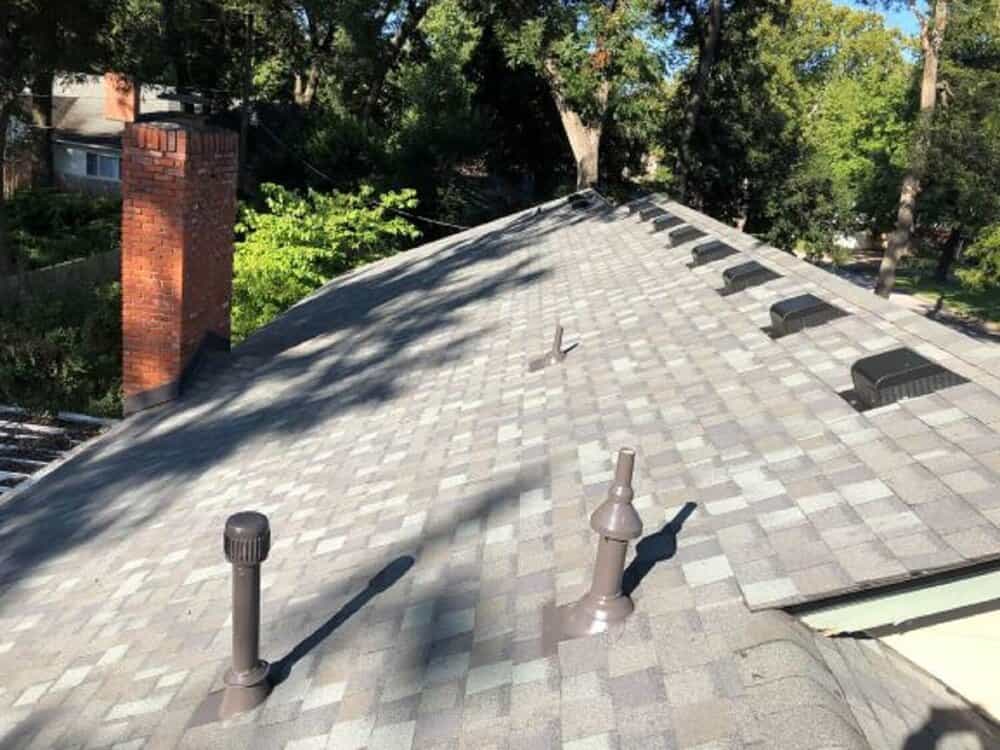
Why Is My Upstairs Or Attic So Hot?
Here’s another frequently asked question: “Why is my upstairs or attic so hot?” There can be many reasons for this. For instance, heat naturally rises, so it’s expected that it would be a bit hotter upstairs than downstairs. Or, maybe the air conditioner doesn’t circulate the air effectively. We are going to look beyond these reasons and explore causes directly related to the roof and attic. If you have ever been in your attic on a hot, sunny day, you will conclude, “This why my upstairs is so hot!” Let’s look at 4 main factors and solutions to an overheated upstairs or attic.
- Roofing Materials
- Bathroom Fans
- Insulation
- Ventilation
Roofing Materials—Is your roofing system a shingle roof? If it is, this can be part of the reason your upstairs is hot. Shingle roofs absorb the heat from the sun. Shingle surface temperatures can be 40-60 degrees hotter than the temperature outside. As the heat is absorbed, the attic warms up.
Solution—The next time your roof is replaced, consider upgrading to a shingle that reflects solar rays. For example, CertainTeed makes the Landmark Solaris shingle. This shingle has an energy-star rating. Who would have ever thought that a shingle would have an energy-star rating? We usually think of those as being reserved for dishwashers and refrigerators.
Bathroom Fans—Bathroom fans are used to expel the warm, humid air out of the bathroom and eventually out of the house. Not all houses have bathroom fans. In other homes, the fans don’t vent out of the house but blow the warm, humid air into the attic. When this happens, there can be a build-up of warm, humid air. This is a problem and can create heat issues upstairs.
Solution—Make sure all bathroom fans are vented outside of the house. There are vents made specifically to connect with bathroom fans. Bathroom fans can be either vented through the roof or on the side of the house. Once the two are connected, all warm air and moisture will then be vented outside, thus limiting the amount of heat and moisture in the house.
Insulation—Many of our customers avoid climbing on their roofs. The same sometimes goes for climbing into a dirty, dusty attic. However, knowing how much insulation you have or don’t have will help determine why your attic is hot.
Solution—Attic insulation is rated at an R-value. Depending on geographic location, the R-value that is needed can range from R-30—R-60. This range can vary, so checking the local building codes would be best. The type of insulation used will determine how many inches of insulation would be required. Measure how much insulation you have. Subtract that number from how much is required by the code.
This should give you an idea if a lack of insulation is causing a heat issue in the attic.
Ventilation—Ventilation for a roof is probably the most important issue. When your attic space is hot during the summer months, there’s no way for the heat to escape. At best, it may cool off slowly and just slightly during the nighttime. At worst, it will not cool off at all. Roof ventilation requires both an intake and an exhaust. Think of a car engine. It has an intake at the front and an exhaust that goes out of the back of the car. If the engine does not have one or the other, that engine will fail. If your roof lacks an intake or an exhaust, it will fail as well, trapping excessive heat and diminishing the longevity of your roof.
Solution—There is a rule to follow in determining the amount of ventilation needed for your home. This rule is called the 1/150th rule or the 1/300th rule. Following this rule is important to meet building codes and shingle manufacturers’ specifications. This rule affects how many roof vents or how many ridge vent is needed as well as the number of soffits or the number of intake vents needed. This rule is based on how much attic floor space your home has. Since every home is different, it’s hard to speculate the amount needed for your home. Once this rule is calculated, it will specifically calculate the number of square inches for intake and exhaust needed. At [company_name] we calculate this formula on every house we work on. If your home doesn’t meet this rule, it could certainly be the reason that your upstairs is so hot.
We hope that this information has helped bring some understanding as to why your attic or upstairs is so hot. Please don’t hesitate to contact us if you need further help.
